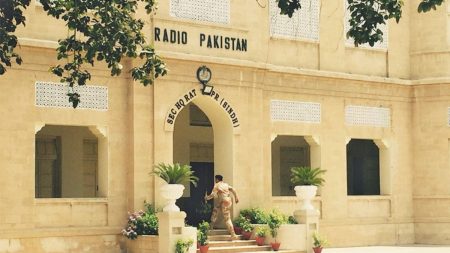Islamabad, Aug 28: The Government of Pakistan’s senior unsecured debt and local and foreign currency issuer ratings have been improved from Caa3 to Caa2, according to Moody’s Ratings (Moody’s). Additionally, we raised the senior unsecured MTN program’s rating from (P)Caa3 to (P)Caa2. The Rating Agency stated that concurrently, the Government of Pakistan’s outlook has shifted from stable to positive.
Pakistan’s improving macroeconomic circumstances, along with somewhat improved government liquidity and external positions from extremely low levels, are reflected in the upgrading to Caa2. As a result, Pakistan no longer faces default risk at a level that is commensurate with a Caa2 rating. The sources of Pakistan’s external funding are now more certain, according to Moody’s, following the sovereign’s staff-level agreement for a $7 billion, 37-month Extended Fund Facility (EFF) with the IMF on July 12, 2024.
According to Moody’s, the EFF should receive approval from the IMF Board in the upcoming weeks. Since June 2023, Pakistan’s foreign exchange reserves have nearly doubled, but they still fall short of what the country needs to cover its external finance obligations. To pay off its external debt in full, the nation still depends on regular funding from recognized allies. Pakistan’s extremely low debt affordability, which raises the danger of high debt sustainability, is nevertheless reflected in the country’s Caa2 rating. Over the next two to three years, interest payments are projected to continue taking up roughly half of government revenue.
The nation’s poor political stability and poor governance are also factors in the Caa2 ranking. A balance of risks that is skewed to the upside is reflected in the optimistic outlook. It represents the prospect that, with the help of the IMF program, the government may be able to significantly reduce the risks associated with external vulnerability and government liquidity while also achieving a stronger fiscal position than is currently anticipated.
Implementing reforms consistently, especially through revenue-raising strategies, can boost Pakistan’s debt affordability and expand the government’s income base. Pakistan would be able to consistently obtain funding from official partners, enough to cover its external debt commitments and enable further rebuilding of its foreign exchange reserves, if it could demonstrate a track record of timely completion of IMF evaluations.
The Pakistan Global Sukuk Programme Co Ltd.’s backed foreign currency senior unsecured ratings have also been upgraded from Caa3 to Caa2. We consider the related financial commitments to be direct liabilities of the Pakistani government. Positive things are ahead for The Pakistan Global Sukuk Programme Co Ltd.
We have also increased Pakistan’s country ceilings for local and foreign currencies from Caa1 to Caa2 and B3 to B3, respectively, in tandem with today’s action. The government’s comparatively broad economic footprint, weak institutions, and significant risk of political and external vulnerability account for the two-notch difference between the sovereign rating and the local currency ceiling.
The relatively weak policy effectiveness and incomplete capital account convertibility are reflected in the two-notch discrepancy between the foreign currency ceiling and the local currency ceiling. It also considers the imposition of convertibility limits and material risks of transfer. It further stated that although risks have decreased from our earlier concerns about the extremely high likelihood of a balance of payments crisis materializing, they are still high because Pakistan still depends on the timely and adequate disbursement of credit from official partners.
Since the IMF staff-level agreement signed on July 12, 2024, there is more certainty over Pakistan’s sources of finance to meet its demands over the next two to three years.In the next weeks, the credit rating agency anticipates that the new $7 billion, 37-month Extended Fund Facility (EFF) will receive approval from the IMF Board. Pakistan is probably going to get help from the IMF program in order to get more funding from other bilateral and multilateral partners.
Due in large part to Pakistan’s excellent performance during the previous nine-month IMF Standby-Arrangement (SBA), which ended in April 2024 and supported macroeconomic stability and led to renewed external financing for the nation, the country’s foreign exchange reserves have also nearly doubled since June 2023. As of August 16, 2024, Pakistan has foreign exchange reserves of $9.3 billion, or slightly less than two months’ worth of imports. By comparison, by the end of June 2023, there will only be $4.4 billion available.
However, Pakistan’s foreign exchange reserves fall far short of what is needed to cover its demands, which emphasizes how crucial it is to make constant progress with the IMF program in order to keep unlocking finance to cover its needs.
According to projections, Pakistan will require nearly $26 billion in external financing for its fiscal year 2025, which ends in June 2025. This amount will be used to pay off approximately $22 billion in principle debt owed to foreign countries and another $4 billion, or roughly 1% of GDP, to cover the current account deficit. Pakistan will have comparable financial demands for the 2026–2027 fiscal year.
According to Moody’s, Pakistan should be able to get the money it needs from official partners, but there is still doubt about the government’s capacity to continue implementing reforms. It’s possible that the coalition government that was created following the February 2024 elections lacks the necessary electoral support to carry out revenue-raising initiatives consistently without inflaming societal unrest. Financing support from official partners may be delayed or discontinued as a result of failures in reform implementation or outcomes.
Although there has been a gradual reduction in spending, the credit rating agency believes Pakistan’s debt affordability would remain extremely low, increasing the danger of debt sustainability. The government’s capacity to allocate funds for fundamental social and economic requirements will continue to be limited as a significant portion of its revenue is allocated to interest payments.
In fiscal 2024, interest payments accounted for over 60% of government revenue. In the fiscal year 2025, interest payments are projected to make up 55–60% of government revenue,prior to falling to roughly 45–50% in the 2026–2027 fiscal year. Pakistan will continue to have some of the highest interest payments among rated sovereigns at these levels relative to government revenue.
Pakistan’s nominal GDP growth and moderate fiscal consolidation have resulted in a high government debt to GDP ratio, albeit one that is slowly reducing. The government’s primary means of achieving considerable budgetary reduction is by raising tax income, which it forecasts will increase by 40% nominally from the previous year to the fiscal year 2025. For fiscal 2025, the government projects a 5.9% GDP deficit and a 2.0% primary surplus (for fiscal 2024, the forecasts are 6.8% deficit and 0.9% surplus, respectively).
Moody’s anticipates that the government will not achieve budget consolidation as quickly as it has planned because significant tax increases may exacerbate societal unrest and force the administration to slow down the process. For the fiscal year 2025, we predict a bigger fiscal deficit of roughly 6.5% of GDP and a lower primary surplus of roughly 0.5–1% of GDP.
A balance of risks that is skewed to the upside is reflected in the optimistic outlook. It accounts for the chance that the government may accomplish a stronger fiscal position than we now anticipate and further minimize the risks associated with government liquidity and external vulnerability.
Establishing a solid track record of reforms that successfully stabilize the economy and public finances would allow Pakistan to access more funding, strengthening the country’s external position beyond what Moody’s presently anticipates. Furthermore, if the $15 billion investment made by the governments of Saudi Arabia and the United Arab Emirates materializes, it will greatly increase Pakistan’s foreign exchange reserves.
In addition, the government wants to increase the size of its revenue base by implementing policies including tax increases on the retail, export, and farm industries. Pakistan’s debt affordability may improve more than we anticipated if these steps are carried out and maintained.









